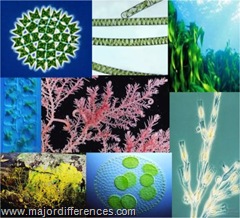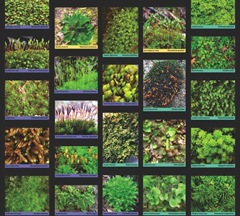Algae: common name for a relatively simple type of eukaryotic plant which is never differentiated into root, stem and leaves; which contains chlorophyll a as the primary photosynthetic pigments; which has no true vascular system; and in which there is no sterile layer of cells surrounding the reproductive organs. The algae range in form from eukaryotic single cells to plants many metres in length. Algae can be found in most habitats on earth, although the majority occur in freshwater or marine environments.
Algae vs Bryophytes
Algae
|
Bryophytes
|
| Usually aquatic habitat | Amphibians of the plant kingdom i.e. grow in moist shady places as well as in water. |
| Plant body unicellular to multicellular, filamentous, thalloid or leafy. | Plant body thalloid or leafy. |
| Tissue differentiation well developed. | Tissue differentiation well developed. |
| Sexual reproduction isogamous, anisogamous or oogamous. | Sexual reproduction oogamous only. |
| Sex organs not covered by sterile jacket. | sex organs covered by a sterile jacket. |
| Female sex organ is oogonium. | Female sex organ is archegonium. |
| Zygote librated from the plant. | Zygote remain enclosed in the archegonium. |
| Embryo is never produced. | Embryo produced from zygote. |
| Sporophyte independent of gametophyte. | Sporophyte dependent upon gametophyte. |
| No such differentiation of the sporophyte. | Sporophyte developed and differentiated into foot , seta and capsule. |
| Mitospores usually present. | Mitospores absent. |
| Homologous alternation of generation. | Alternation of generation is Heteromorphic |

